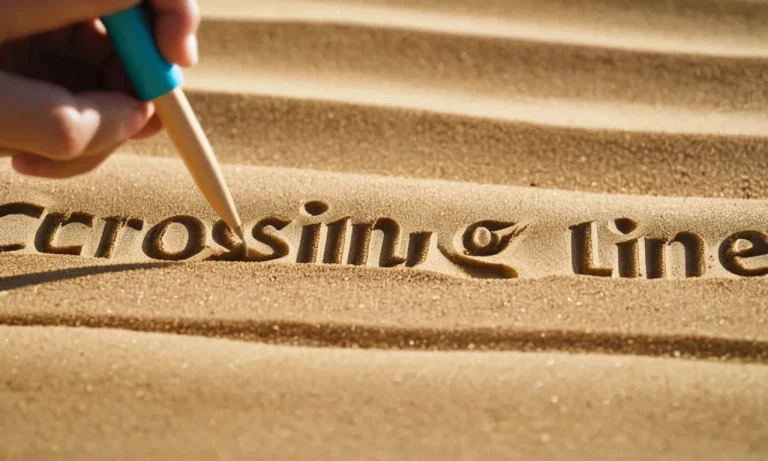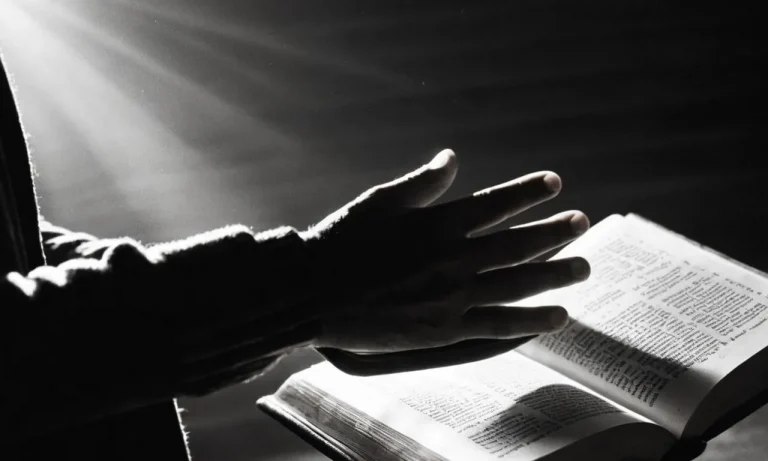Who Sits At The Left Hand Of God?
The question of who sits at the left hand of God is one that has intrigued countless people over the centuries. If you’re short on time, here’s a quick answer: According to the Bible, Jesus Christ sits at the right hand of God the Father in Heaven.
In this comprehensive article, we will examine the biblical basis for this belief, explore what sitting at the ‘right hand’ signifies, look at objections and alternative theories, and reflect on the deeper meaning and implications of Christ’s position of honor and authority.
Biblical Basis for Christ Sitting at God’s Right Hand
Psalm 110 Verse 1
Psalm 110:1 is considered a messianic prophecy that foretold of Jesus Christ’s exaltation to the right hand of God. This verse states, “The Lord says to my lord: ‘Sit at my right hand until I make your enemies a footstool for your feet.'”
Here, David speaks of two lords – God the Father and God the Son, Jesus Christ. Though Jesus walked the earth in humility, this verse prophesies His future glorification and enthronement at the right hand of God the Father.
Mark 16 Verse 19
After His resurrection, Mark 16:19 records, “After the Lord Jesus had spoken to them, he was taken up into heaven and he sat at the right hand of God.” This event occurred forty days after Jesus’ resurrection from the dead, when He bodily ascended into heaven as His disciples watched.
Jesus’ sitting down at the right hand of God signifies His ascension to a position of power, authority, and honor after completing His earthly ministry and defeating sin and death on the cross.
Romans 8 Verse 34
The apostle Paul affirms Christ’s exalted position in Romans 8:34 – “Who then is the one who condemns? No one. Christ Jesus who died – more than that, who was raised to life – is at the right hand of God and is also interceding for us.”
Here, Paul emphasizes that Jesus’ sacrifice, resurrection, and ascension to the Father’s right hand guarantees believers absolute security from condemnation. No one can condemn those who are in Christ.
Ephesians 1 Verse 20
Ephesians 1:20 elaborates on the great power displayed in raising Jesus from the dead and seating Him at God’s right hand: “He exerted when he raised Christ from the dead and seated him at his right hand in the heavenly realms.”
Christ’s position at the Father’s right hand means all things have been put under His feet, that He reigns above all rule and authority, and His Church is strengthened by His supreme power.
Colossians 3 Verse 1
Paul instructs believers in Colossians 3:1, “Since, then, you have been raised with Christ, set your hearts on things above, where Christ is, seated at the right hand of God.” Here, Paul connects the believer’s resurrection life spiritually with Christ to His bodily resurrection and ascension.
Believers are called to focus on heavenly pursuits rather than earthly ones, knowing Christ reigns in power and authority at God’s right hand.
Hebrews 10 Verse 12
The book of Hebrews provides perhaps the clearest explanation of what Christ’s position at God’s right hand signifies. Hebrews 10:12 states, “But when this priest had offered for all time one sacrifice for sins, he sat down at the right hand of God.”
Here the author explains that Christ’s work of atonement was completed through His sacrifice on the cross, allowing Him to sit down in the place of highest honor – at the Father’s right hand.
The Significance of ‘Sitting at the Right Hand’
A Position of Honor
Sitting at the right hand of God is a position of great honor and authority. In ancient times, the right side was seen as the place of power, strength, and preeminence. When a king wanted to bestow special honor on someone, he would invite them to sit at his right hand.
Therefore, for Jesus to sit at the right hand of God the Father is an exalted position showing His honor and divine authority.
Several verses in the Bible mention Jesus sitting at God’s right hand, including Ephesians 1:20, Hebrews 1:3, Hebrews 10:12, and 1 Peter 3:22. These verses teach us that after His sacrificial death and resurrection, Jesus ascended into heaven and was given the highest place of honor and sovereignty next to God the Father.
His exaltation shows that Jesus is co-equal with God and rules over all creation.
A Position of Authority
Sitting at the Father’s right hand also signifies that Jesus shares in God’s mighty power and authority. From this dominant position, Christ governs the forces of the universe and the church. Ephesians 1:22 states that God “placed all things under His feet and appointed Him to be head over everything for the church.”
And 1 Peter 3:22 explains that Jesus “has gone into heaven and is at God’s right hand—with angels, authorities and powers in submission to him.”
So Jesus is not passively sitting by God’s side. He is actively ruling with all authority as King of kings and Lord of lords (Rev. 19:16). From the honored position at God’s right hand, Christ intercedes for believers (Rom.
8:34), guides the church by pouring out the Holy Spirit (Acts 2:33), and orchestrates the defeat of His enemies (Ps. 110:1).
A Heavenly Priesthood
Lastly, the right hand of God signifies Jesus’ appointment to a permanent, heavenly priesthood. Under the old covenant, priests stood to minister sacrifices. But Hebrews 10:11-12 contrasts this imperfect priesthood with Christ, who “sat down at the right hand of God” after offering His sacrifice.
His seated position shows that His atoning work is finished and accepted by the Father.
Unlike the human, imperfect priests on earth, Jesus serves as the perfect High Priest in God’s presence (Heb. 8:1-2). He represents believers before God’s throne, continually interceding and advocating for us (Heb. 7:25).
This privilege of living forever as our heavenly Priest is granted to Christ because of His sinless life, sacrificial death, and victorious resurrection.
Objections and Alternative Theories
Despite the belief that Jesus Christ sits at the right hand of God, some have objected or offered alternative theories. Here are some of the key objections and theories that have been put forward:
Jesus is not God
Some religious groups such as Jehovah’s Witnesses believe that Jesus is not God but rather the first creation of God. Since he is not God, he cannot sit at the right hand of God. This view challenges mainstream Christian doctrine about the divinity of Christ.
Jesus did not bodily ascend to heaven
Some scholars believe the accounts in Acts about Jesus ascending bodily into heaven should not be taken literally. They argue the ascension stories are symbolic rather than historical. According to this view, Jesus did not literally ascend and therefore could not be seated at the right hand of God.
Sitting denotes authority, not location
More liberal theologians suggest that being seated at God’s right hand is a metaphor denoting the authority of Christ rather than a physical location. Just as ancient kings would seat their heirs next to them to share in ruling, Jesus being at God’s right hand means he shares in God’s rule.
Others may share God’s throne
While most Christian teaching focuses on Christ at God’s right hand, some think other spiritual beings may share in sitting on the heavenly throne. Passages like Daniel 7:9-10 describe a scene where the “Ancient of Days” (God) takes his throne while thousands upon thousands minister to him.
Some scholars propose this may refer to other divine beings surrounding the throne.
So while throughout church history most Christians have accepted Christ’s ascension and session at God’s right hand as core doctrine, alternatives have been offered that challenge or reinterpret traditional beliefs. The objections keep the question open: Who really sits at the left hand of God?
Reflections on Christ at God’s Right Hand
The Bible teaches that after His resurrection and ascension, Jesus Christ is now seated at the right hand of God the Father in heaven (Mark 16:19; Acts 7:55-56; Romans 8:34; Ephesians 1:20; Colossians 3:1; Hebrews 1:3; 8:1; 10:12; 12:2).
This position of honor and authority indicates His equality with God and His role as Lord of all.
Sitting at God’s right hand speaks of Christ’s supreme exaltation. The right side has traditionally been seen as the place of power and authority. So for Jesus to sit at God’s right hand means He shares in God’s glory and dominion over all things (1 Peter 3:22).
Now Christ reigns as King of Kings and Lord of Lords (Revelation 17:14; 19:16).
Furthermore, sitting implies completion of His sacrificial work of redemption on the cross. Just as the high priest in the Old Testament finished his ministry and sat down once a year (Hebrews 10:11), so Jesus sat down, having accomplished fully the sacrifice for sins.
From then on, He waits expectantly until His enemies are made a footstool for His feet (Hebrews 10:12-13).
Christ’s position at God’s right hand also signifies His role as heavenly High Priest. Having offered the perfect and definitive sacrifice, He has passed into the true tabernacle in heaven and now intercedes constantly for those who draw near to God through Him (Hebrews 8:1-2).
What assurance for the believer to know Christ prays and advocates for them!
Moreover, to be at God’s right hand is to have supreme authority to rule. All authority in heaven and earth has been given over to Jesus (Matthew 28:18). He is exalted as Ruler over all the works of God’s hands; all things will be put under His feet as He reigns until the last enemy is abolished (Psalm 8:6; 110:1; 1 Corinthians 15:25).
What a mighty and triumphant King we serve!
How humbling and awe-inspiring to reflect on Christ sitting victoriously at the Father’s right hand. He is our Prophet, Priest and King ruling the cosmos. Let us then bow the knee joyfully before such a great Savior and worship Him alone as the Lord of all.
Conclusion
In conclusion, the biblical testimony clearly indicates that Jesus Christ alone sits at the right hand of God the Father in Heaven. This position signifies Christ’s honor, authority, and heavenly priesthood as the exalted Son of God.
While objections have arisen over the years, the overwhelming scriptural evidence supports the historic Christian belief in Christ seated at God’s right hand.








